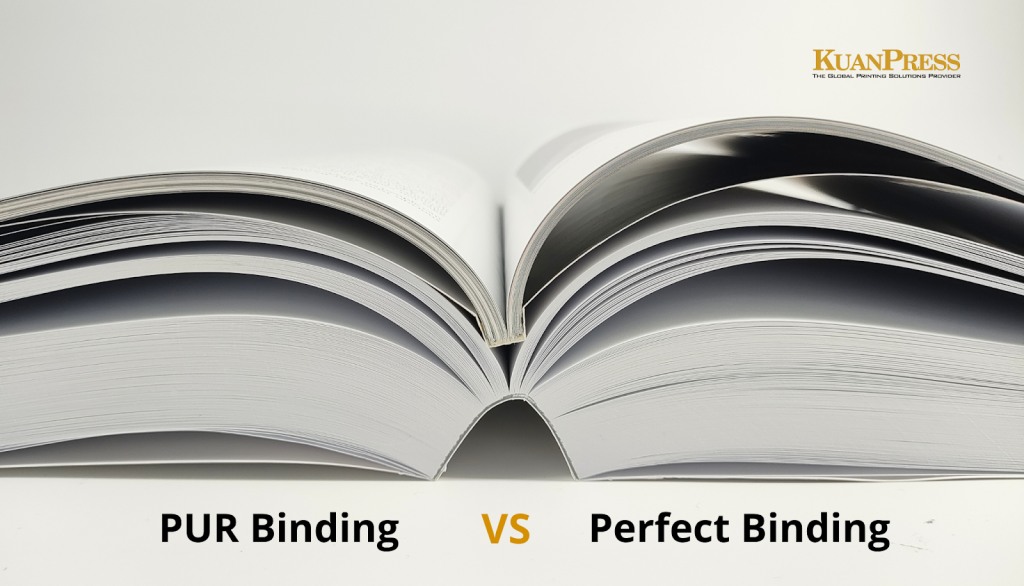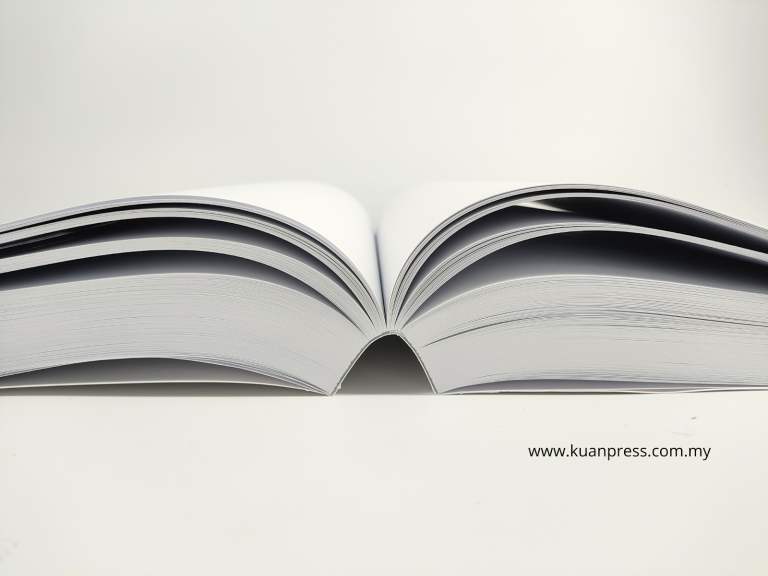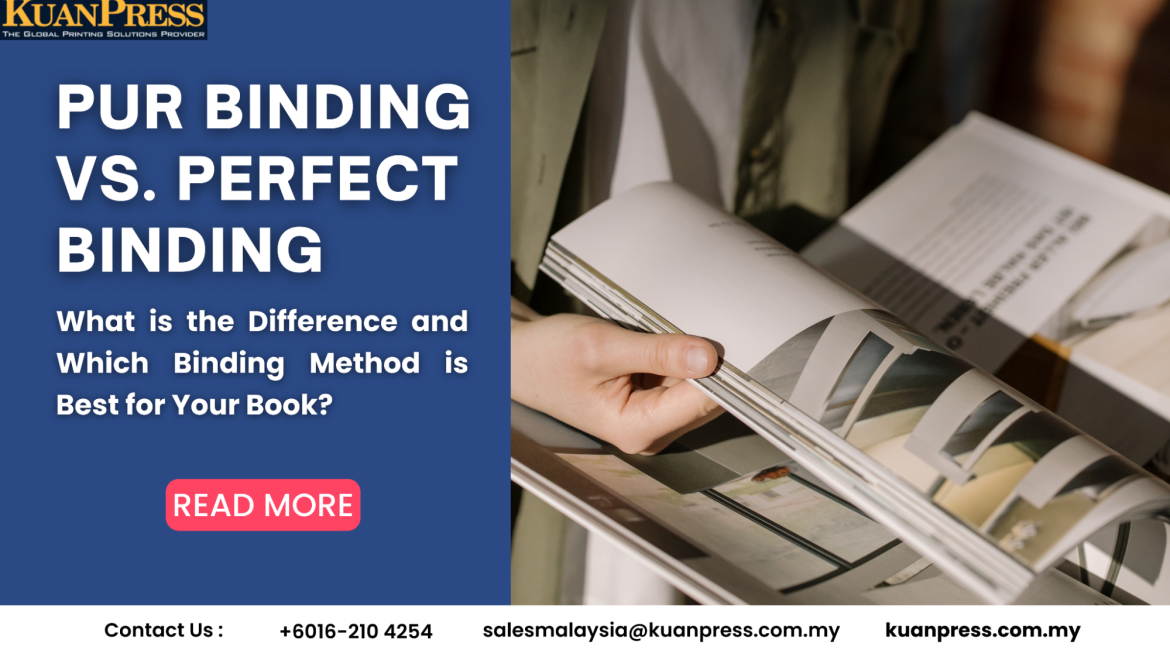PUR Binding vs. Perfect Binding: What is the Difference and Which Binding Method is Best for Your Book?

Choosing the right binding method is a crucial step in ensuring your printed materials look professional and remain durable. Two of the most common binding techniques in the book printing industry are PUR binding (Polyurethane Reactive) and perfect binding. While both methods are widely used, they serve different purposes and offer varying benefits. This article will break down the key differences between these methods and help you decide which is best suited for your book project.
What is PUR Binding?

PUR binding, or Polyurethane Reactive binding, uses a special adhesive known for its strength, flexibility, and durability. Unlike traditional adhesives, PUR has superior bonding properties, making it ideal for books that need to withstand heavy use or lay flat without damaging the spine.
Key Features of PUR Binding:
- Durability: PUR binding is perfect for books that will be handled frequently, such as catalogs, manuals, and textbooks.
- Flexibility: This binding allows books to open fully without cracking the spine, making it a preferred choice for thicker volumes.
- Longevity: PUR adhesive resists yellowing and deterioration, meaning it retains its strength over time, even with constant use.
- Temperature Resistance: PUR performs exceptionally well under extreme temperature conditions, making it suitable for environments where the book may experience heat or cold.
- In industries like FMCG, where durability and flexibility are key, PUR binding ensures that essential materials like product catalogs and manuals maintain their quality through frequent handling and usage.
What is Perfect Binding?

Perfect binding uses ethylene vinyl acetate (EVA) adhesive to glue the pages to the spine of the book. It is widely recognized for its aesthetic appeal and is frequently used in paperback novels, magazines, and marketing brochures.
Key Features of Perfect Binding:
- Cost-Effective: Perfect binding is an affordable option for large print runs, making it a go-to choice for budget-conscious projects.
- Aesthetic Appeal: The smooth, clean finish of perfect binding provides a professional look, which is ideal for promotional materials, softcover books, and catalogs.
- Suitability for Light Use: Perfect binding is best for books with a shorter lifespan or those that won’t face extensive handling, such as magazines or seasonal brochures.
Perfect binding is a fantastic option for FMCG brands looking to create marketing materials like brochures or product booklets where budget and quick turnaround times are crucial.
Key Differences Between PUR Binding and Perfect Binding
| Criteria | PUR Binding | Perfect Binding |
|---|---|---|
| Adhesive Type | Polyurethane Reactive (PUR) adhesive | Ethylene Vinyl Acetate (EVA) adhesive |
| Durability | Highly durable, ideal for heavy-use books | Suitable for light to moderate use |
| Flexibility | Allows the book to lay flat without spine damage | Less flexible, prone to spine cracking over time |
| Cost | More expensive due to specialized adhesive and equipment | More affordable and faster to produce |
| Production Time | Longer production time due to curing process | Faster production, ideal for tight deadlines |
| Applications | Textbooks, catalogs, manuals | Magazines, brochures, paperbacks |
| Environmental Impact | Some PUR adhesives are eco-friendly | EVA adhesives are less environmentally sustainable |
| Shelf Life | Long-lasting and durable | Shorter lifespan |
When to Choose PUR Binding and Perfect Binding?
The right binding method depends on your specific project requirements, including durability, cost, and the type of book you’re producing. Here’s a quick guide:
Choose PUR Binding if:
- Your book will be handled frequently, such as catalogs, manuals, or educational materials.
- You need a flexible binding that allows books to lay flat without spine damage.
- Longevity is important, as PUR binding offers superior durability and temperature resistance.
- You want archival-quality binding for materials that will last over time, like annual reports or corporate manuals.
Choose Perfect Binding if:
- You are working with a tight budget, and cost is a primary concern.
- Your project has a quick turnaround, and you need a faster production process.
- The book is intended for short-term use, such as promotional materials or brochures for FMCG products.
- You want a clean, professional appearance without the need for high durability.
Real-World Use Cases: PUR Binding vs. Perfect Binding for FMCG
In the Fast-Moving Consumer Goods (FMCG) sector, both PUR and perfect binding play vital roles. For instance, product catalogs that need to be referenced frequently by sales teams or distributors would benefit from the strength and flexibility of PUR binding. The ability of the pages to lay flat while open, without damaging the spine, ensures that these materials last even with regular use.
On the other hand, FMCG companies might prefer perfect binding for seasonal brochures or product guides that won’t be in circulation for long. These materials require a clean, professional appearance, but since they don’t need to endure constant handling, the cost-effective nature of perfect binding makes it the preferred choice.
Environmental Considerations on PUR Adhesives
If environmental impact is a consideration, it’s important to note that some PUR adhesives are formulated to be more eco-friendly, offering a sustainable solution for long-lasting materials. In contrast, perfect binding with EVA adhesive tends to be less environmentally sustainable but still offers cost and time benefits for projects that have a shorter lifespan.
Thoughts on choosing between PUR binding and Perfect binding for your book
Understanding the differences between PUR binding and perfect binding is essential to making the right decision for your book or printed material. If your project demands long-term durability, flexibility, or resistance to wear, PUR binding is your best option. However, if your focus is on affordability and aesthetic appeal for short-term materials, perfect binding provides a practical solution.
When deciding between the two, always consider the purpose of the material, its expected lifespan, and how often it will be handled. For high-quality, durable books, PUR binding is worth the investment, while the perfect binding is an excellent choice for cost-sensitive projects that still require a polished, professional look.
Still unsure what method would be better for your print project?
If you need further assistance or have any questions about PUR Binding or Perfect Binding and would like to discuss your options for the upcoming project, please for personalized advice call Kuan Press Sdn Bhd a call at +6016-2104254 or email salesmalaysia@kuanpress.com.my. We look forward to helping you create high-quality, durable, and professional printed materials!

